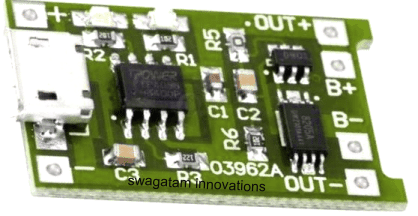In this discussion we try to learn the right procedure for selecting a charger for a Li-ion battery. The question was raised by Mr. Akshay.
Li-Ion Charger Related Question
I have a 5000mAh Li-ion battery. Can i select a charger for my Li-ion battery having the following specifications, the product is available on ebay?
I will be thankful if you can help me with a better option or alternate options over this.
Thanks & Regards,
Akshay G. Anarse

Specifications of the Li-ion Battery charger
Lithium Ion Battery/Cell Charging Module with CC-CV operating mode, high performance output.
Just because you can Charge your Li-ion battery optimally, a Li-Ion charger would need 5V mini from a PC USB source, in order to ensure a direct charging of the battery from the PC.
RED led illumination indicates charging mode, while the BLUE Led glows as soon as the battery is Full.
Module Specifications: non-isolated module with Li-ion/Li-Po protection chip.
- Size: 25x19mm
- Color: As shown in the ebay picture
- Maximum current charging Temperature: 30 c
- Input voltage: 5V via Micro usb or from any external 4.5V -5.5V DC power supply.
- Output voltage for charging the battery to full level : 4.2V
- Output current: 1A, and self-adjusting as per the battery mAH specs
- Charging Method: CCCV (Constant Current-Constant Voltage)
- Protection Chip included: S 8205A
- Operating Temperature for this module is as per the Industrial grade (-10 to +85 )
Solving the Circuit Problem
Hi Akshay,
Your Li-ion Battery is rated at 5000mAH, so charging it at a 1 amp rate could cause a slow charging of the battery, and could take many hours, therefore selecting the charger for your Li-ion battery is OK, but will have this drawback.
In order to charge your battery at a faster rate, a preferable rate would be 3 amp, higher charging rates up to 5 amps could be tried but that would cause some heating of the battery and therefore might demand a temperature controlled circuit.
A fan cooling could be used for keeping the heat of the battery under control so that the battery is able to charge quickly at a 1C rate.
Here "C" refers to the AH rating of the battery, therefore 1C signifies charging of the Li-ion at its full 5 amp rate.
Instead of going through the hassles of selecting a charger for a Li-ion battery from the market the unit could be built and used at home by following the instructions as explained in this Li-ion battery charger circuit with auto cut off
Dear,
I've had a small palm sized i-pod given by a friend which was not charged, so when i kept it to charge after some time the i-pod started getting warm. After unplugging the i-pod it didn't accept any charge.
When upon opening I've figured out a small li-ion battery which is just 100mAH.
My queries-
What does it indicate if the battery is getting warm during charging?
What happens to the internal resistance of the battery?
Does li-ion battery have any liquid inside that dries up over time?
Fortunately, the i-pod circuit is working fine when connected to another good cell.
Hi,
slight warming while charging is not bad and is normal especially with Li-ion cells, but heating above around 45 degrees must be avoided
internal resistance will increase on heating and will cause an increased inefficiency.
Internally it has the chemical LiCoO2 in electrolyte form sandwiched between its +/- electrode plates
not sure whether the chemical can dry up overtime or not